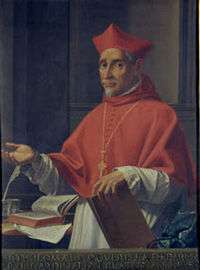Bartolomeo Roverella
Bartolomeo Roverella (1406–1476) (called the Cardinal of Ravenna) was an Italian Roman Catholic bishop and cardinal.


Biography
Bartolomeo Roverella was born in Rovigo in 1406, the son of Palatine Count Giovanni Roverella (camerlengo of Leonello d'Este, Marquis of Ferrara), and his wife Beatrice de' Leopardi di Lendinara.[1] Bartolomeo Roverella received a doctorate in law.[1]
After completing his education, Roverella became a clerk of the Bishop of Modena.[1] He was next a chaplain of the Patriarch of Aquileia.[1] He then moved to Rome and became secretary to Pope Eugene IV.[1]
On July 15, 1444, he was elected the first ever Bishop of Adria.[1] He was promoted to the metropolitan see of Ravenna on September 26, 1445.[1]
He was present in Rome for the papal conclave of March 1447.[1] He became a papal chamberlain to Pope Nicholas V and auditor of the Roman Rota.[1] He served as governor of Umbria from 1448 to 1451.[1] In 1451, he was appointed nuncio to the Kingdom of England.[1] From 1452 to 1455, he was governor of Marche Piceno.[1] In 1459, he served as governor of Viterbo.[1] Pope Pius II named him papal legate to the Kingdom of Naples in 1460.[1] He was then governor of Benevento from 1460 to 1466.[1]
In the consistory of December 18, 1461, Pope Pius II made him a cardinal priest while Rovarella was in his legation to Naples.[1] Upon his return to Rome on January 26, 1462, he was awarded the titular church of San Clemente, and then received the red hat on January 30, 1462.[1]
On February 13, 1464, he returned to the Kingdom of Naples, where he supported Ferdinand of Aragon against René of Anjou.[1]
Cardinal Roverella returned to Rome on August 23, 1464, and participated in the papal conclave of 1464 that elected Pope Paul II.[1] On January 8, 1470, Paul II named him papal legate to Perugia.[1]
He returned to Rome on August 1, 1471 to participate in the papal conclave of 1471 that elected Pope Sixtus IV.[1] The new pope named him legate to the March of Ancona and he left for his legation on October 24, 1471.[1] He returned to Rome in 1473.[1]
On January 12, 1475, he was elected Camerlengo of the Sacred College of Cardinals.[1]
He died in Ferrara on May 2, 1476.[1] He is buried in San Clemente.[1]
References
| Wikimedia Commons has media related to Bartolomeo Roverella. |
- Miranda, Salvador. "ROVERELLA, Bartolomeo (1406-1476)". The Cardinals of the Holy Roman Church. Florida International University.
| Catholic Church titles | ||
|---|---|---|
| Preceded by Berardo Eroli |
Camerlengo of the Sacred College of Cardinals 1475 |
Succeeded by Jacopo Piccolomini-Ammannati |